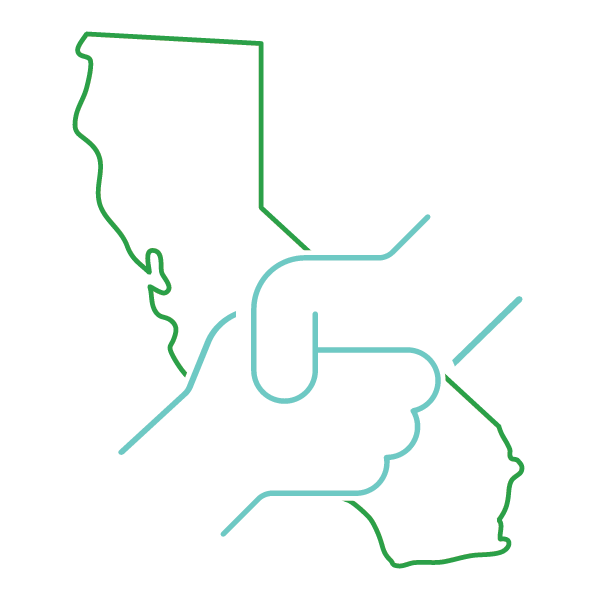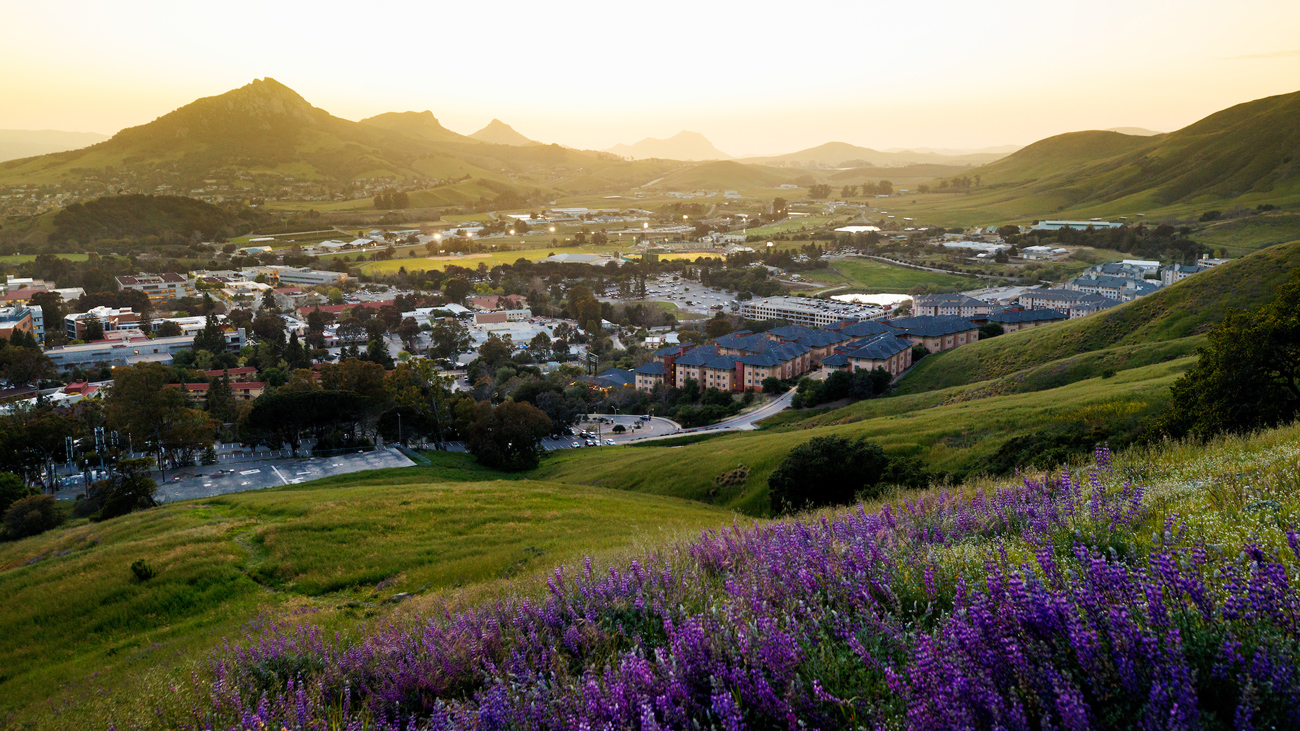
Campus News
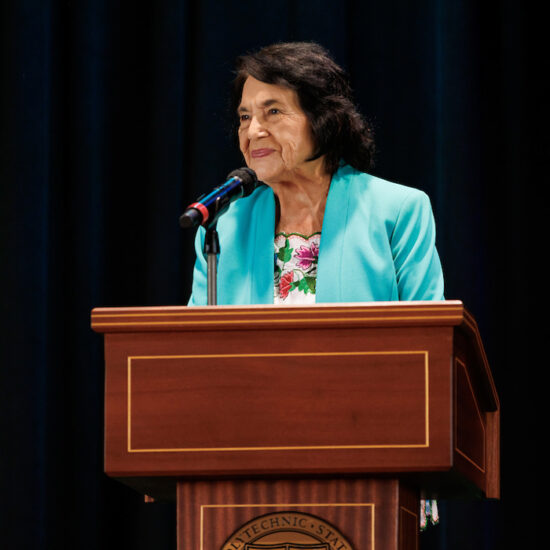
Dolores Huerta speaks at Cal Poly. Photo by Joe Johnston.
¡Si, Se Puede!
Legendary labor organizer Dolores Huerta was the closing keynote of ¡Adelante!, the inaugural Hispanic-Serving Institution Symposium: Pathway to Becoming an HSI, organized by the Office of University Diversity, Equity and Inclusion.
The symposium, held Oct. 17, featured a welcome address from President Jeffrey Armstrong, a panel discussion with Cal Poly’s HSI Task Force, a fair highlighting Latinx-centered resources on campus and afternoon workshops.
In her speech, Huerta, who co-founded the United Farm Workers alongside Cesar Chavez in the early 1960s, asked the audience to remember their common humanity, take care of each other, vote and remember their power.
“People that are affected by issues in their community, they have to learn and understand that they have the knowledge of how to solve their problems. They don’t have to wait for somebody to come in from the outside and solve the problems for them,” she said. “This is what we have to do: is continue organizing people and let them know that they can make it happen.”
The title of the symposium, ¡Adelante!, means “forward” in Spanish, and that was the spirit of the day: honoring the past, celebrating the present and envisioning a future full of forward momentum and progress as Cal Poly strives to become an HSI.
— Gabby Ferreira
Read the full story on Cal Poly News.
Seen and Heard
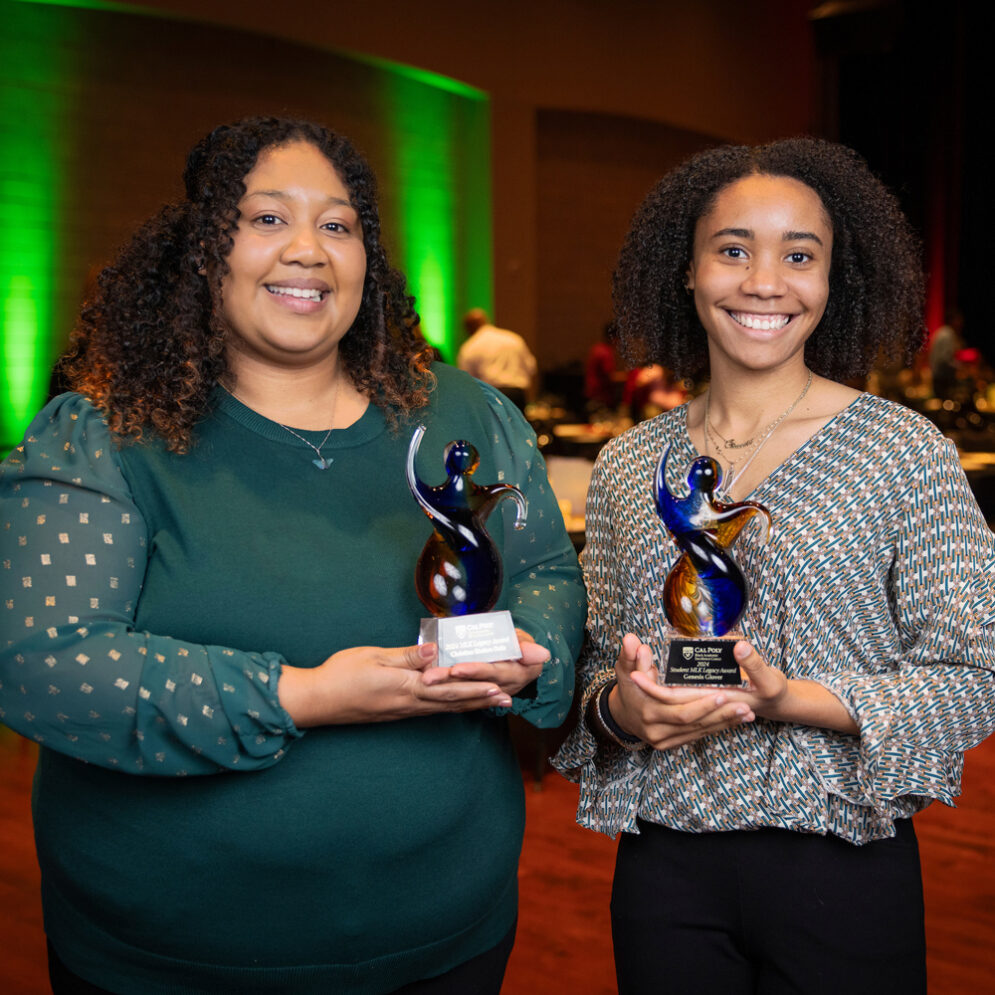
Cal Poly has provided me so many opportunities to fully embrace who I am and discover the voice that I have — to learn to be a better leader.
— Genesis Glover (right), vice president of the Black Student Union and recipient of the 2024 MLK Legacy Award. Staff member Christina Sholars Ortiz (left) was also honored for her work leading the Black Academic Excellence Center. Explore Q&A’s with Glover and Sholars Ortiz on the Cal Poly News site.
California Impact
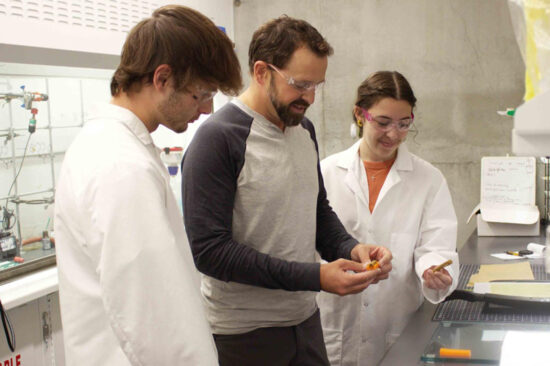
Chemistry major Ryan Donnelly (left) and biochemistry major Sophia Newcomer work on an innovate glue product with Cal Poly chemistry Professor Phil Costanzo.
Dual Breakthroughs
In the fall, Cal Poly faculty filed patents for two incredible inventions: one an innovative, ecofriendly glue and the other an early-detection system for wildfires.
The glue, formally known as D-Glue (for “debondable glue”) was created by Cal Poly chemistry professor Phil Costanzo and Geisys Ventures CEO Kris Stokes.
Extreme heat is typically required to separate recyclable materials from the glue currently in use — which is often cost-prohibitive — but D-Glue is designed so it can be broken apart at lower temperatures while maintaining the integrity of the item. Costanzo and Stokes hope to launch D-Glue broadly as a commercial product, offering companies a glue that makes it economically feasible to recycle these valuable components.
The D-Glue patent, approved Nov. 21, creates a pathway for proprietary commercial production of the glue innovation under the direction of Geisys Ventures.
“Being able to do meaningful research as an undergrad is such a huge opportunity and unique to Cal Poly and its Learn by Doing mission,” said Sophia Newcomer, a second-year biochemistry major and Frost Fund program researcher on the project.
Meanwhile, two engineering professors recently filed the patent, “Using Power Infrastructure for Wildfire Detection,” which is already attracting significant interest from utility companies.
Electrical engineering professor Majid Poshtan and computer engineering professor Joseph Callenes-Sloan grounded their method on the observation that radiated heat from a fire changes transmission line temperatures, causing them to expand and sag.
By tracking those changes, the duo determined that wildfires can be quickly identified around electric transmission networks.
The inspiration behind the approach came from the tragic 2018 Camp Fire, which was caused by a faulty electric transmission line. They ultimately pioneered an approach that will enable an entity not only to detect a fire but to determine its direction and speed, with updates coming every 25 seconds.
“In the beginning, we asked ourselves, ‘Is there a way we can help with our technical background?” Callenes-Sloan said. “So, we took our skills and applied them to a method aimed at protecting people and communities, and we believe it will have a real-world impact.”
— Nick Wilson and Emily Slater
By the Numbers
California Impact
California’s Hidden Black History
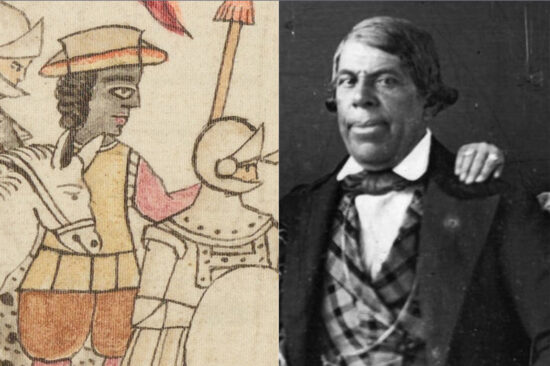
Left: An illustration of Juan Garrido, a Black Spanish soldier who accompanied Hernando Cortes on his expeditions in Mexico. Right: A photo of Pio Pico, the last Mexican governor of California and one of the most prominent Californios of African descent.
History professor Cameron Jones and computer science professor Foaad Khosmood are heading up an interdisciplinary research team working to unearth the largely untold history of settlers of African descent in early California.
“In a lot of cases, people of African descent have been erased from the historical narrative,” says Jones. “It’s deep within our history, but no one talks about it. We’re trying to reverse that erasure in talking about the American West and California specifically, by helping people understand the importance of these groups.”
By developing digital tools to analyze early Spanish colonial records, Jones and his colleagues are building resources that will help shine a light on the history of people of African descent among the Californios — a multicultural group of people who populated the region between Spanish colonization and the annexation by the United States.
In their day-to-day work on the project, Jones and a group of student researchers analyze records from a database called the Early California Population Project, a digitized set of birth, death and baptism records from the first decades of Spanish colonial history in California.
Khosmood and his students are working to develop programs that can replicate the kinds of decisions and inferences a trained historian might make about incomplete records, and then use machine learning techniques to automate those processes to help fill the gaps in thousands of data points in the historical record.
The next steps for the project will be to develop a publicly available online resource at AfricanCalifornios.org. The team also plans to begin gathering stories to flesh out the data, and to work with teachers to develop interactive maps, guides and lesson plans that update the state’s ubiquitous fourth-grade California history courses.
“Working on this project has shifted what I want to do,” says Evan Witulski, a recent computer science graduate who helped develop those digital tools. “I really love sitting down with an interesting problem and building out a program to fix it. This project helps me get better at approaching tasks and problem solving.”
— Larry Peña
Read the full story on Cal Poly News.
In the Headlines
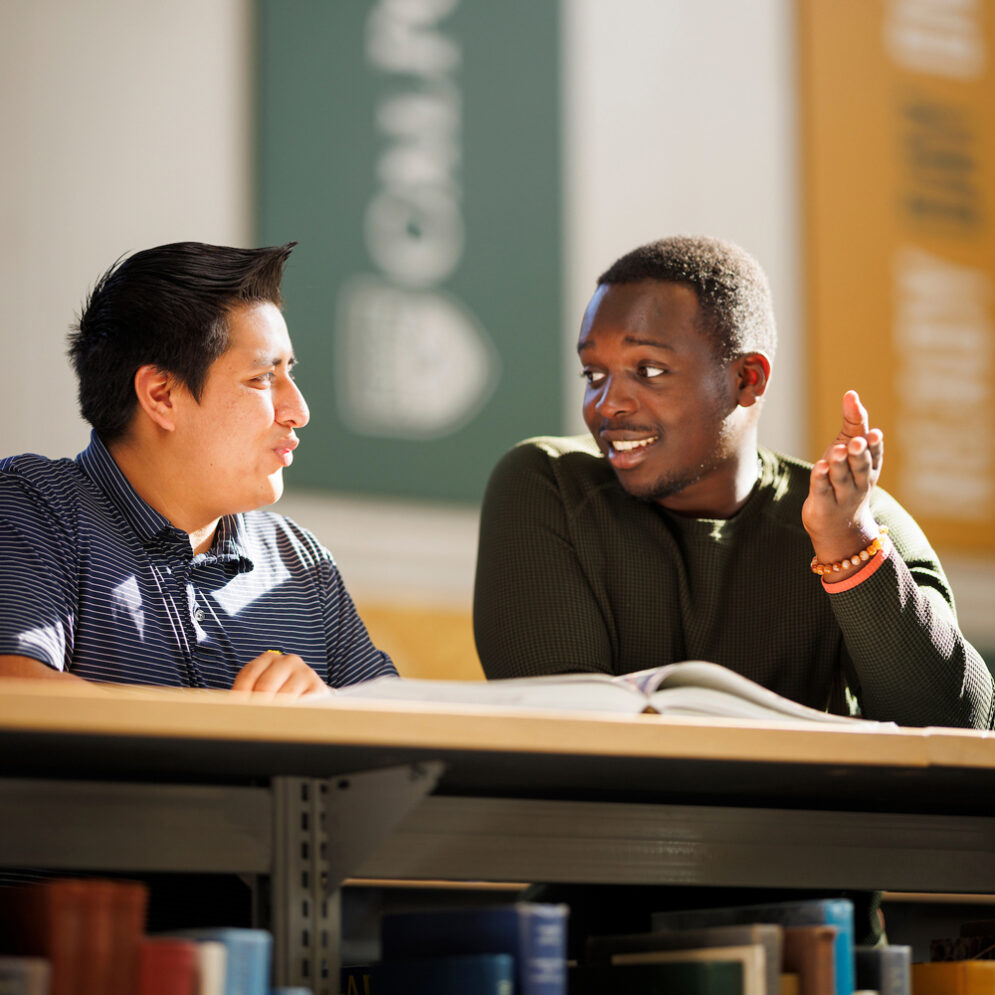
Transfer Power
According to the U.S. Department of Education, Cal Poly has the highest graduation rate — 89% — of transfer students among four-year institutions in California. That rate is tied for the highest of any institution in the nation. The data says nearly 40% of all students transfer schools at some point during their post-secondary journey.
Campus News
Serving Those Who Serve
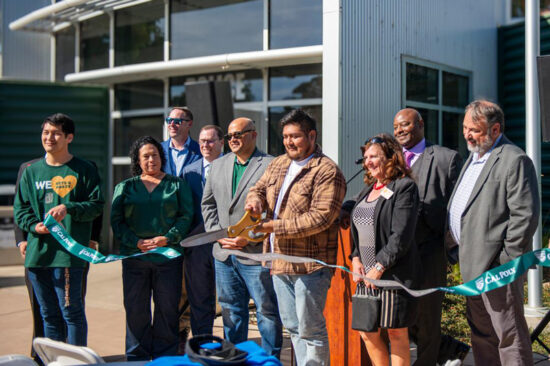
The Center for Military-Connected Students has offered support for veterans and dependents of veterans for nearly a decade — and recently moved into a brand-new space.
The center serves about 700 military-connected students and offers programs including orientations on university services, student success strategies and food insecurity to social outings, career goals and family support when active-duty parents are deployed far away.
“One constant throughout has been the strong sense of community that I have found at the Center for Military-Connected Students,” said David Gaspar-Martinez, a fourth-year psychology student, at the expanded center’s dedication on Nov. 9. Gaspar-Martinez, a student veteran, transferred to Cal Poly from Allan Hancock College in 2022. “Since I arrived, the center has served as a welcoming and safe space.”
The new facility is double the size of the original center, ADA-compliant, with many enhanced benefits for students: more indoor and outdoor study space, new computers, free printing, a bigger food pantry and air conditioning. The food pantry alone has received more than 850 visits since September.
And a major part of what the center provides is something integral to student success: community.
“What the research says is that military-affiliated students and student veterans who build a community of support will do better. They will graduate sooner. They report that they have better health and well-being,” said Kari Leslie, the center’s coordinator. “Military-affiliated students need connection.”
The dedication for the center’s new space comes on the heels of the U.S. News & World Report’s annual Best College’s guidebook, released in September, that ranked Cal Poly as the top school in the West for veterans for the fourth straight year.
— Jay Thompson
Read the full story on Cal Poly News.


